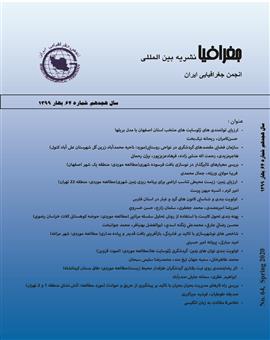سازمان فضایی مقصدهای گردشگری درنواحی روستایی (نوع مقاله : پژوهشی)
محورهای موضوعی :هاجر مزیدی 1 , رحمت اله منشی زاده 2 , فرهاد عزیزپور 3 , بيژن رحماني 4
1 - علوم زمین
2 - شهید بهشتی
3 - دانشگاه خوارزمی
4 - دانشگاه شهيد بهشتي
کلید واژه: برنامه ریزی فضایی سازمان فضایی مقصدهای گردشگری روستایی ناحیه محمدآباد زرین گل,
چکیده مقاله :
گردشگری روستایی نیز جزئی از گردشگری محسوب می شود که در یك اقتصاد پیرامونی قرار گرفته که نه تنها باعث توسعه مناطق روستایی و محلی نشده، بلکه سبب ایجاد عدم تعادل های محیطی وفضایی نیز در این مناطق گردیده و در نتیجه منافع بسیار اندکی از این فعالیت اقتصادی عاید روستائیان گشته و عمده منافع و هزینه های آن به مادر شهرها و شهرهای بزرگ جهان سوم و در نهایت به شرکت های فراملیتی و بزرگ بر می گردد(Holland at all,.2003).دراین راستاتوجه به امربرنامه ریزی فضایی ضرورت پیدامی کند. این نوع برنامه ریزی به طورخاص به عنوان رویکردی تاثیرگذاردرهدایت سازمان یابی فضایی گردشگری است که باید موردتوجه قرارگیرد. پژوهش حاضربراساس هدف کاربردی و روش تحقیق توصیفی- تحلیلی است، برای گردآوريِ اطلاعات به شیوه ي اسنادي و میدانی عمل شده است. جامعه آماري موردمطالعه،شامل 20 مقصدگردشگري روستایی درناحیه محمدآباد- زرین گل واقع در شهرستان علی آبادکتول بوده است، برای وزن دهی معیارهاازروش(AHP)، براي امتیاز نهایی و رتبه بندي مقصدها از روش پرومتی و براي سطح بندي مقصدهاي گردشگري از روش تحلیل خوشه اي استفاده شده است؛همچنین برای تعیین حوزه عملکردی مقصدهای گردشگری روستایی ازنقطه شکست درمحیط نرم افزار(GIS) استفاده شده است.نتایج تحقیق نشان دادکه عدم تناسب در توزیع سطوح مقصدهاي گردشگري روستایی درمحدودموردمطالعه،یکی از چالش هاي مهم سازمان فضایی توسعه گردشگري این ناحیه به شمار می آید. نتایج تحقیق بازگو کننده این است که عدم توجه نظام برنامه ریزی نسبت به پراکنش مقصدهای گردشگری درچارچوب سازمان فضایی مناسب،سبب بروزنابرابری ونهایتا تضعیف جایگاه مقصدهای گردشگری ناحیه مورد مطالعه نسبت به سایرمقاصد گردشگری درنواحی دیگرمی شود.
Rural tourism is also considered as a part of tourism that is located in a peripheral economy that not only does not promote rural and local areas, but also creates environmental and social imbalances in these areas, resulting in very little benefit; and, as a result, this economic activity (Rural Tourism) creates very little benefit for the villagers, and the major benefits and costs return to the mother cities and large cities of the Third World, and ultimately to transnational corporations (Holland et all, 2003). In this regard, paying attention to planning (specially space planning) becomes necessary. This kind of planning should particularly be considered as an effective approach to the issue of tourism space organization. On the basis, the present study looks for the space administration of tourism destination in the rural areas of Mohammad Abad-Zarrin Gol area (the city of Ali Abad Katoul) as one of the tourism destinations. The methodology of the study is quantitative and its method is descriptive, and the data have been collected through a documentary and field manner. The statistical population included 20 rural tourism destinations in Mohammad Abad-Zarrin Gol area in Ali Abad Katoul city. It has been used the AHP method for rating factors, the Prometheus method for final score and ranking the destinations, and cluster analysis method for leveling the tourism destinations; as well, to determine the functional area of rural tourism destinations, GIs point of deflection in the sofware environment has been applied. The results of the study showed that the disproportion in the distribution of rural tourism destinations in the intended area of the study is one of the important challenges of the space administration of tourism development of this area.
